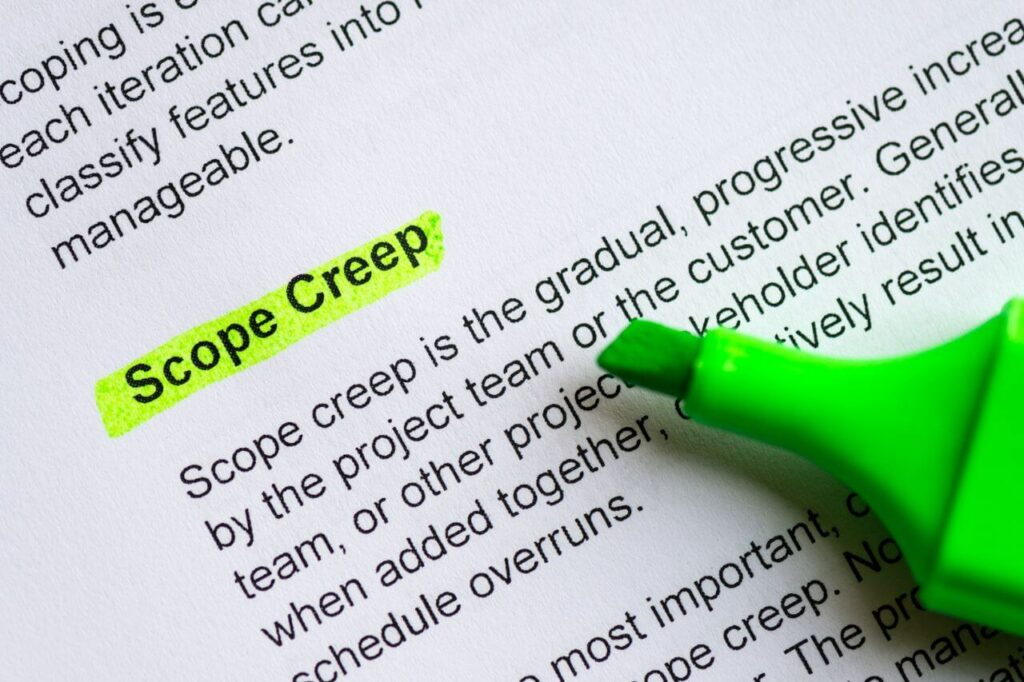When we talk about managing projects in the traditional or waterfall approach, one of the top risks every project manager tends to be wary of is scope creep.
This is because in the waterfall project management approach, the scope is fixed during project planning, and one of the roles of the project manager is to ensure the project’s scope is stuck to as much as possible.
This is however a quite different story when we are dealing with projects using the Agile methodology, as the methodology’s core is basically to be as flexible as possible, and welcome change.
The Agile methodology is all about adapting and changing the original scope and requirements to respond to customers’ needs and market developments.
Since the core of Agile involves constantly refining the scope to adapt according to empirical evidence, is there really scope creep in Agile projects?
We are going to take a look at the concept of scope creep in Agile projects, if it does exist, and how to handle it if it does.
Scope Management in Agile Projects
The first thing we need to talk about is the concept of scope in Agile projects and how to manage it effectively.
The scope of an Agile project is a combination of the product scope and the project scope.
The product scope is defined as the requirements, features, and functions of the product as requested by the Product Owner (PO).
While the project scope is the work that must be done to deliver the product with the requested features and functionalities.
The scope of the product is defined in the Product Backlog which is managed by the Product Owner and is a core responsibility of this role.
Scope management in Agile projects entails creating the Product Backlog based on the Product Goal, prioritizing it, redefining it throughout the project, and dealing with changes to the backlog.
Unlike traditional project management which has a scope statement managed by the project manager, the Product Backlog of an Agile project embodies its scope and is managed by the Product Owner.

Scope Creep In Agile Projects
Scope creep occurs when the requirements of a project start to expand during execution beyond what was originally agreed upon. This can lead to delays, increased costs, and frustrated team members.
The concept of scope creep in Agile projects is quite different from traditional projects where changes to the scope are often a bad thing.
Since the Agile methodology embraces changes to the scope to allow incremental development based on feedback, does that mean all changes to the Product Backlog should be welcomed with open arms? No.
For projects using the Agile methodology, changes in the scope are expected and welcome as long as it makes the project more aligned towards the project or product goal.
It’s important how the changes to the scope are managed. This involves anticipating and identifying the scope creep, evaluating its impact on the project goal, and dealing with these changes.
To be clear, scope creep in Agile projects is not just the addition of features to the project scope, it’s the uncontrolled addition of features that aren’t instrumental to the overall project goal.

Causes of Scope Creep in Agile Projects
In order to manage scope creep in Agile projects, you need to first know the factors that could lead to it.
This way, you can be proactive about managing the scope or Product Backlog.
Some factors that could cause scope creep in Agile projects include:
1. Poorly Defined Project Goal
One major factor that will surely lead to scope creep is if the goal of the project is not clearly defined and communicated from the start. That is a recipe for failure.
This is more common than you may think as a lot of Product Owners are not sure of what they want to achieve, or find it difficult to express it to the Agile team.
When this happens, it’s impossible to know whether changes to the Product Backlog are required or not.
2. Unrefined Product Backlog
Another cause of scope creep is when the Product Backlog is not properly refined.
The Product Backlog entails the scope of the product including its features, functionalities, user stories, and bugs.
A good Product Backlog must be aligned with the goal of the product and the overall business vision and needs to be constantly refined to reflect this.
The Backlog is created by the Product Owner and prioritized for development in iterations or sprints. After each sprint, the Product Backlog should be refined based on feedback from the sprint.
Agile thrives on rapid feedback and adaptation based on that feedback and Product Backlog items should be developed according to priority.
If this Product Backlog is not constantly refined and prioritized, Product Backlog items that are not relevant to the product goal end up being developed leading to scope creep.
3. Poor Communication
Communication may sound easy but you can be assured that most problems with a project originate from poor communication.
Communication is the bedrock of project management and it’s estimated that as a project manager, you spend up to 80% of your time on communication.
Poor internal and external communication happens to be a major cause of scope creep in Agile projects.
The project team especially the developers needs to have a clear and concise vision of the goal of the product and this has to be communicated to them.
Failure to do this will lead to the team not providing the right feedback that is necessary for adaptation which is one of the benefits of Agile.
The team also needs to communicate clearly the impediments faced while developing the product.
External communication with stakeholders and customers is another cause of scope creep.
The product is built for the stakeholders and end-users, and it’s important they communicate clearly the problems and the kind of solution that is desired.
When this communication is poor, the necessary alignment between the stakeholders, product goal, and the project team is not there and scope creep is likely.
4. Lack of Customer Involvement
Customer collaboration and satisfaction are the bedrock of the Agile methodology.
In order to satisfy customers, you need to deliver value to them through products that provide solutions to their needs.
Agile projects rely on customer involvement to ensure that was it is being developed is actually what the customer needs.
If the customer is not involved in the project development, it can lead to scope creep as requirements or features are added without their input.
For example, if a project team is developing a new software product, but the end-users are not involved in the development process, it can lead to scope creep as the project’s scope expands beyond what the end-users actually need or want.
Read Also: 8 Incredible Benefits Of Nearshore Agile Software Development For Your Business

How to Identify Scope Creep in Agile Projects
You need to fully understand why it’s called scope creep. It creeps up on your project and you may not even notice that you are building a product with features not relevant to the product goal.
It’s important to be proactive about it and actively check constantly to identify scope creep the moment it begins to rear its head.
When managing Agile projects, these are some ways to check for and identify scope creep:
1. Review the Project Scope
Regularly review the project scope and compare it to the original requirements and deliverables to identify any new tasks or features that have been added without proper approval or agreement.
2. Monitor Project Timelines
Keep track of project timelines and deadlines, and look for any delays or changes that may be caused by scope creep.
3. Track changes to the project scope:
Use an Agile project management tool to keep track of changes to the project scope and ensure that they are properly approved and incorporated into the project plan.
4. Monitor Team Workload
Keep an eye on the team workload and look for any signs of team members being overworked or overburdened, which can be an indication of scope creep.
5. Monitor the Project Budget
Regularly review the project budget and compare it to the original estimates, and look for any unexpected increases which could be an indication of scope creep.
6. Monitor Customer Feedback
Keep an eye on customer feedback and be aware of any additional requirements or changes that may be requested, and make sure that they are properly approved before being incorporated into the project.
7. Use Metrics to Measure Progress
Measure progress using metrics such as burndown charts and velocity to identify any changes that may be caused by scope creep.
How to Handle Scope Creep in Agile Projects
With this understanding of what scope creep means for an Agile project and the factors that can lead to it, the next thing you need to know is how to handle it.
Good project management is about being proactive and actively putting measures in place to forestall things that could go wrong, rather than being reactive by waiting for them to occur and dealing with them.
The following tips can help you in handling scope creep in your Agile project and develop products that are aligned with the product goal.
1. Start the Project with a Properly Defined Project Goal
It’s difficult to build the right product if the purpose of the product is vague. So from the project initiation, let the goal will well-defined.
One way of doing this is by using a Statement of Work (SOW) to define the product goals and objectives, deliverables, and product requirements.
While the product requirements are expected to evolve, the goal remains fixed barring changes to make conditions or customer requirements.
The SOW should be documented and include the following:
- Product goal.
- Project deliverables.
- Prioritized product requirements.
- Acceptance criteria for the deliverables.
- Delivery timeline.
- What is not in the scope.
2. Product Backlog Grooming
The link between the goal of a project and the developed product is the Product Backlog which is the scope of an Agile project.
Just like in traditional project management, scope management remains essential to project success.
Therefore, the Product Backlog must be managed and refined properly in order to develop not just any product with a load of features, but one that meets the goals and objectives of the project.
Product Backlog grooming or refining is key to effective Product Backlog management.
To do this involves adding product requirements, features, and user stories, to the Product Backlog before pushing them for development in sprints.
The Product Backlog items have to be prioritized according to the product goal and the development team takes items from this prioritized list that can be completed in a sprint.
For every new sprint, the Product Backlog should be reevaluated and prioritized with the knowledge from the previous sprint, and items no longer relevant should be removed.
This enables the development team to only work on features relevant to the overall product goal and avoid scope creep.
3. Develop and Implement a Communication Plan
Although the Agile manifesto advocates for an emphasis on working software over extensive documentation, ideally some documentation is still required.
Communication is a very important aspect of managing Agile projects that helps to foster transparency and collaboration.
You need to develop a plan for communicating with your team and external stakeholders. The plan should be implemented and constantly monitor to ensure that it is being followed and is effective.
The plan should include what project aspects should be communicated and to who, the channels to use, and the frequency of communication.
This way, you will be able to notice early when the development of the product is not going according to the scope or timelines and you then have an avenue to stop scope creep in its infancy stage.
Read Also: How Do Agile and DevOps Interrelate?
4. Active Customer Involvement in Development Process
An Agile project without active customer involvement is a recipe for disaster.
The product is built for the customer’s satisfaction and if they’re not involved, it will likely lead to scope creep and a bunch of product features that provides no value for the customer.
To prevent this, it’s important to involve the customer more actively in the product development process.
This can be done by regularly communicating with them, getting their input and feedback on the project requirements and deliverables.
This helps ensure that the project is meeting their needs and that new requirements or features are being added with their input.
Also. set up regular check-ins with the customer to review the project progress and gather feedback to ensure that the project stays on track and that any new requirements or changes are identified and addressed early on.
Prioritizing customer requirements against the original project requirements and making sure that the most important tasks are completed first also helps ensure that the project stays on track and that the customer’s needs are being met.
Using metrics such as customer satisfaction surveys, user testing and feedback is also a good way to measure progress and identify any changes that may be caused by a lack of customer involvement.
Transparent communication with the customer about the project scope and any new requirements or changes that are added is also important.
This will help the customer understand the impact of these changes on the project timeline and budget.
Conclusion
The flexibility of Agile projects can easily be a double-edged sword. In a bid to rapidly adapt, lots of changes may come up and it is quite easy to deviate from the original purpose of the project.
As part of managing your project risks, you need to constantly be on guard against gold plating and scope creep.
By following these tips, you should be able to identify and handle scope creep in Agile projects and build the right products.





